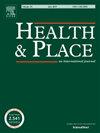Spatial modelling to identify high-risk zones for the transmission of cutaneous leishmaniasis in hyperendemic urban environments: A case study of Mashhad, Iran
IF 3.8
2区 医学
Q1 PUBLIC, ENVIRONMENTAL & OCCUPATIONAL HEALTH
引用次数: 0
Abstract
Spatial modelling was employed to identify high-risk zones for the transmission of cutaneous leishmaniasis in hyperendemic urban environments, focusing on Mashhad, Iran. Data analysis from 3033 CL patients (2016–2020) integrated socio-demographic, environmental, and geological factors using negative binomial regression and the technique for order of preference by similarity to ideal solution (TOPSIS) model. Findings indicate that 42.8% of the study area, affecting 20% of Mashhad's population, is at heightened risk due to factors such as high illiteracy rates, dense populations, poor built environment quality, and specific geological conditions. The model achieved an area under the curve (AUC) of 0.83, signifying strong discrimination, with Kappa statistics (KNO = 0.60, K standard = 0.56) showing substantial agreement. These insights can be used to inform targeted surveillance and effective disease control strategies.
通过空间建模确定高发城市环境中的皮肤利什曼病传播高风险区:伊朗马什哈德案例研究。
采用空间模型确定高流行城市环境中皮肤利什曼病传播的高危区,重点是伊朗马什哈德。数据分析来自3033例CL患者(2016-2020),采用负二项回归和TOPSIS模型的偏好排序技术,综合了社会人口、环境和地质因素。研究结果表明,由于文盲率高、人口密集、建筑环境质量差和特定的地质条件等因素,42.8%的研究区域(占马什哈德人口的20%)面临更高的风险。模型的曲线下面积(AUC)为0.83,判别性较强,Kappa统计量(KNO = 0.60, K标准= 0.56)基本一致。这些见解可用于为有针对性的监测和有效的疾病控制战略提供信息。
本文章由计算机程序翻译,如有差异,请以英文原文为准。
求助全文
约1分钟内获得全文
求助全文
来源期刊

Health & Place
PUBLIC, ENVIRONMENTAL & OCCUPATIONAL HEALTH-
CiteScore
7.70
自引率
6.20%
发文量
176
审稿时长
29 days
期刊介绍:
he journal is an interdisciplinary journal dedicated to the study of all aspects of health and health care in which place or location matters.
 求助内容:
求助内容: 应助结果提醒方式:
应助结果提醒方式:


